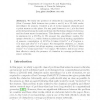Free Online Productivity Tools
i2Speak
i2Symbol
i2OCR
iTex2Img
iWeb2Print
iWeb2Shot
i2Type
iPdf2Split
iPdf2Merge
i2Bopomofo
i2Arabic
i2Style
i2Image
i2PDF
iLatex2Rtf
Sci2ools
WADS
2007
Springer
2007
Springer
Computing Best Coverage Path in the Presence of Obstacles in a Sensor Field
We study the presence of obstacles in computing BCP(s, t) (Best Coverage Path between two points s and t) in a 2D field under surveillance by sensors. Consider a set of m line segment obstacles and n point sensors on the plane. For any path between s to t, p is the least protected point along the path such that the Euclidean distance between p and its closest sensor is maximum. This distance (the path’s cover value) is minimum for a BCP(s, t). We present two algorithmic results. For opaque obstacles, i.e., which obstruct paths and block sensing capabilities of sensors, computation of BCP(s, t) takes O((m2 n2 + n4 ) log(mn + n2 )) time and O(m2 n2 + n4 ) space. For transparent obstacles, i.e., which only obstruct paths, but allows sensing, computation of BCP(s, t) takes O(nm2 + n3 ) time and O(m2 + n2 ) space. We believe, this is one of the first efforts to study the presence of obstacles in coverage problems in sensor networks.
| Added | 09 Jun 2010 |
| Updated | 09 Jun 2010 |
| Type | Conference |
| Year | 2007 |
| Where | WADS |
| Authors | Senjuti Basu Roy, Gautam Das, Sajal Das |
Comments (0)

